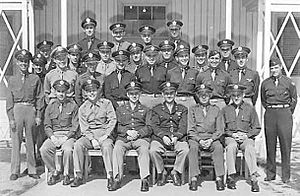Condor Field facts for kids
Condor Field was an important airbase in Twentynine Palms, California. It was used to train pilots and soldiers during both World War II and the Korean War. Before and after these wars, it was a regular airport for planes. Today, this old airfield is part of the Marine Corps Air Ground Combat Center Twentynine Palms. It started around 1939 as a small airport called Twenty Nine Palms Airfield. It had a 3,000-foot runway next to Mesquite Lake.
Contents
History of Condor Field
World War II Training
On January 1, 1942, the military took over Twenty Nine Palms Airfield. They renamed it Condor Field. It became a training center for United States Army Air Forces pilots learning to fly military gliders. The Army built a large landing area, about 1,800 by 3,000 feet, for this training.
Condor Field was mainly used as a United States Army glider school during World War II. Because they needed more space, the Twentynine Palms Airport, located six miles east, was also used for glider training. The training center was called the Twenty-Nine Palms Air Academy. It had four smaller airfields nearby to help with all the training.
Pilots learned to fly using planes like the Fairchild PT-19 and PT-17 Stearman. They also had a few P-40 Warhawk planes. For glider training, they used Waco CG-4 gliders. The Academy trained pilots from March 1943 to April 1944. General Henry H. Arnold, who was in charge of the Army Air Forces, wanted 150 glider pilots trained for World War II. By the end of the war, over 6,000 glider pilots had been trained. About 1,654 of these pilots learned at the Twentynine Palms Air Academy.
Training Units at Condor Field
Several groups were stationed and trained at Condor Field:
- The 17th Army Air Forces Flying Training Detachment.
- The Air Depot Detachment, which supported the Twentynine Palms Air Academy.
- The Army Air Forces Weather Station, type C.
- The Civil Contract Flying School.
After World War II
After the Invasion of Normandy on June 6, 1944, glider training was no longer needed. All training stopped by April 1944, and the airfield closed. Later in 1944, the United States Navy took over the airfield. They renamed it the Twentynine Palms Naval Auxiliary Air Station.
Under Navy control, it became a support airfield for NAS San Diego. The original glider landing area was not strong enough for the Navy's larger planes, like the Lockheed Ventura and Consolidated PB4Y-2 Privateer. So, the Navy built a new runway on the dry lake using special metal mats called Marston Matting. After the war, in October 1945, the Navy closed the station. Condor Field then became a regular civil airport again, now with a 4,000-foot paved runway.
Korean War and Closure
When the Korean War started, the military needed a place for live-fire training. So, in 1952, Condor Field reopened. It was renamed Marine Corps Training Center Twentynine Palms. The airfield was called an "expeditionary airfield," meaning it could be set up quickly for military use. A second 6,000-foot steel-mat runway was added for jet planes and large cargo planes.
In December 1969, the very large Lockheed C-5 Galaxy cargo plane came out. This meant there was a need for an even longer paved runway to support such heavy aircraft. A brand new airfield was built in 1976, about eight miles northwest of the original Condor Field. In 1979, Condor Field officially closed as the new airfield was fully ready. The old Condor Field is now near the main entrance to the Marine Corps Air Ground Combat Center Twentynine Palms, off the west side of Adobe Road.




